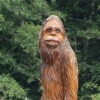I just got home from a truly rotten camping trip. The goal was to use a metal detector to find a revolver I lost over 5 years ago. The trip grew to an extended family camping trip, with different members coming and going at will, and the Mrs. going sooner than planned, and with an attitude.
Well, at least my last night there was quiet and peaceful.
It started with the search for the gun. I didn't find it. I found a brown tarp covered with brown leaf litter, and covering bones. The weren't moose bones. Before I instinctively threw back the tarp completely searching for a skull, I realized tgat regardless of the species of the bones, foul play was pretty apparent with the tarp scenario. The bones looked like they could be pig, goat, sheep,..........or a smaller human.
Had to call the Troopers. The Troopers called in a federal Refuge LEO, picked me up at the campground, and met the fed near the site. I led them to the find.
Did they look like they were concerned about "contamination"? Not one bit. They threw back the tarp and began digging through the leaf litter with their bare hands collecting bones. They didn't care when I joined the bare hand digging and bone collecting. There was no skull, and there were thankfully too many ribs to be human. Their quick determination was that somebody had poached a Dall sheep or mountain goat (both of which are plentiful in the immediate area), took the head, and dumped the carcass for me to find in the future. They arranged the bones on the forest floor, with bare hands, took pics of the bones, and said that they'd send the wildlife enforcement guy back to the site for "further investigation".
The "contamination" line is just that; a line of bs they use the contaminate a ruling they don't like.
The only saving grace regarding the trip was that it wasn't human. There will be no more nightmares (I had a doozy the night before I left on the trip...........got into a fight with a freak at my Mother's front door, and in the imaginary scuffle, I fell out of bed...........never did that before), no trips to the DAs office or courtroom, etc.
Imagine the big time trouble a sasquatch carcass would get ya'.........even if you just stumbled upon it.



